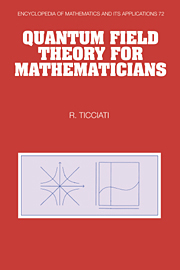Book contents
- Frontmatter
- Contents
- Preface
- Introduction
- 1 Relativistic Quantum Mechanics
- 2 Fock Space, the Scalar Field, and Canonical Quantization
- 3 Symmetries and Conservation Laws
- 4 From Dyson's Formula to Feynman Rules
- 5 Differential Transition Probabilities and Predictions
- 6 Representations of the Lorentz Group
- 7 Two-Component Spinor Fields
- 8 Four-Component Spinor Fields
- 9 Vector Fields and Gauge Invariance
- 10 Reformulating Scattering Theory
- 11 Functional Integral Quantization
- 12 Quantization of Gauge Theories
- 13 Anomalies and Vacua in Gauge Theories
- 14 SU(3) Representation Theory
- 15 The Structure of the Standard Model
- 16 Hadrons, Flavor Symmetry, and Nucleon-Pion Interactions
- 17 Tree-Level Applications of the Standard Model
- 18 Regularization and Renormalization
- 19 Renormalization of QED: Three Primitive Divergences
- 20 Renormalization and Preservation of Symmetries
- 21 The Renormalization Group Equations
- Appendix
- References
- Index
15 - The Structure of the Standard Model
Published online by Cambridge University Press: 31 October 2009
- Frontmatter
- Contents
- Preface
- Introduction
- 1 Relativistic Quantum Mechanics
- 2 Fock Space, the Scalar Field, and Canonical Quantization
- 3 Symmetries and Conservation Laws
- 4 From Dyson's Formula to Feynman Rules
- 5 Differential Transition Probabilities and Predictions
- 6 Representations of the Lorentz Group
- 7 Two-Component Spinor Fields
- 8 Four-Component Spinor Fields
- 9 Vector Fields and Gauge Invariance
- 10 Reformulating Scattering Theory
- 11 Functional Integral Quantization
- 12 Quantization of Gauge Theories
- 13 Anomalies and Vacua in Gauge Theories
- 14 SU(3) Representation Theory
- 15 The Structure of the Standard Model
- 16 Hadrons, Flavor Symmetry, and Nucleon-Pion Interactions
- 17 Tree-Level Applications of the Standard Model
- 18 Regularization and Renormalization
- 19 Renormalization of QED: Three Primitive Divergences
- 20 Renormalization and Preservation of Symmetries
- 21 The Renormalization Group Equations
- Appendix
- References
- Index
Summary
Presenting the most successful theory in the history of science; its structure, some characteristic effects, anomalies, and overall consistency.
Introduction
The Standard Model of electroweak and strong interactions is the basis for all highenergy particle theory. It has achieved such wide acceptance that the primary test for the validity of a model in high-energy physics is that it yields this theory at sufficiently low energies. The Standard Model is an extension of the Weinberg—Salam model of the electroweak interactions to include quantum chromodynamics (QCD), the quark-gluon theory of the strong interactions.
The Weinberg—Salam model is a gauge theory, built around the group SU(2) × U(1). As a gauge theory, it has massless vector bosons for each symmetry generator. However, massless bosons correspond to long-range forces and would therefore have been detected long ago. Hence the theory includes a means for giving the vector bosons masses; it proposes the existence of some scalar fields (Higgs fields) and a gauge-invariant potential for them whose classical minima are only invariant under a U(1) subgroup of SU(2) × U(1). When the symmetry breaks, the vector field associated with the unbroken symmetry remains massless and is identified with the photon, but those associated with broken symmetries become massive, and we are reconciled with experimental evidence regarding massless vector bosons.
- Type
- Chapter
- Information
- Quantum Field Theory for Mathematicians , pp. 454 - 479Publisher: Cambridge University PressPrint publication year: 1999



